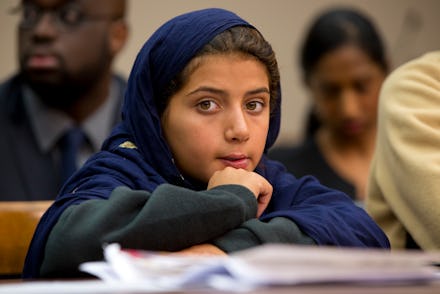What It's Like to Live With Drone Strikes, In Victims' Own Words

You’ve heard about drones. You know what they do. You know that we use them to fight terrorism and protect American soldiers from the risks they would face on the ground. Yet the Obama administration, when deciding to employ drones, may not have considered those most affected: innocent civilians. In Pakistan, Yemen, and Somalia, drones have become an integral part of civilians' lives. Even those who have not lost a loved one cannot ignore the noise and the damage drones cause.
Since the U.S. stared using drones in 2004, hundreds of civilians have been killed in Pakistan alone. 200 of them are believed to be children. Here are several first-hand accounts from Pakistan that will help you understand what life is like for ordinary people living under the constant threat of drone strikes.
1. Living in fear of the sky
Earlier this week, nine-year-old Nabila Rehman testified before a congressional committee about how she witnessed her grandmother being killed by a drone strike as she was picking okra in a field. Only five congressmen attended the hearing.
Her brother Zubair had more to add about living under the threat of drone strikes: "I no longer love blue skies. In fact, I now prefer grey skies. The drones do not fly when the skies are grey... When the sky brightens, drones return and we live in fear." Zubair described the sound they make as a continuous zung, zung, zung. "It's something that a two year old would know ... We hear the noise 24 hours a day," he said.
2. Being told to be silent
Those who want to speak out about the horror drone strikes have caused in Pakistan are often accused of being spies for either the U.S. or the Pakistani government. That can translate to a death sentence. "You can put a gun to my head but do not record my interview," said one drone witness.
"Some persons came to me here, I didn’t know them, whether they were Taliban or the people from the Agency; they warned me to behave... I was clearly threatened that I should not give any information about the victims," another anonymous civilian stated.
It’s not uncommon to find civilians who have had relatives or friends killed or critically injured by drones, but who are unable to complain to authorities because they fear for their own lives.
3. At risk while working
In July 2012, an attack on the village of Zowi Sidgi killed 22 miners and injured about 20 others. The workers were killed while gathering for break in a tent. "It was our gathering place; usually at the end of the day after work the villagers sit together and talk to each other about our daily business," said one miner. It was difficult to find bodies still intact.
One witness recalled his friend, Bengal Khan, a 28-year-old married father of four who was the sole breadwinner for his family: "I think of him constantly, he was very funny and always smiled... He would sing... He’d make everyone in the village laugh. He was a very kind man and very sociable." Since the attack, Khan's family has been "left destitute."
4. Losing a baby niece
Saddam, a teenage boy in Waziristan, recounted his story in the documentary, Wounds of Waziristan. Saddam lost his sister-in-law and baby niece in an attack on his home. His brother experienced severe and continuous psychological trauma.
The drones cause severe psychological problems, even for those who have not lost a loved one. "They fly very low at night. It's very stressful. A lot of people lose their minds," Saddam says.
Javed Akhtar, a psychiatrist who treats patients traumatized by drones, says families "often get no closure" because the bodies of their loved ones are so badly mangled.
5. What we need to take away from these stories
These stories show immense human suffering that we, as Americans, need to acknowledge and be sensitive to if we hope to effectively combat terrorism. By ignoring the deaths of these civilians, we tacitly imply that their lives are worth nothing, that they are less human than American citizens.
We need to pay attention to these stories and a slew of others about innocent lives taken by drone strikes. Our government cannot keep ignoring how devastating drone strikes have been to populations who have no role in terrorist militias, and often, are threatened by them. These victims are no less human than we are, and our time to further investigate the human cost of drone strikes is long overdue.